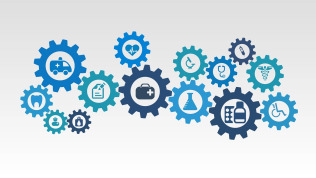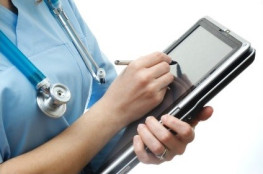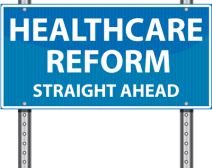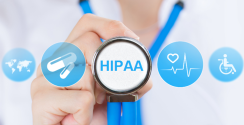 This past year, 2017, has been a challenging year for many industries, and healthcare is certainly no exception. Not only are there major challenges connected to an increasingly aging population and outdated healthcare infrastructure, but the industry is also adapting to the policies associated with a new presidential administration. While technology will continue to be a key part of the future of healthcare, one of the biggest changes will be a shift in mindset from mobile technology to mobile patients.
This past year, 2017, has been a challenging year for many industries, and healthcare is certainly no exception. Not only are there major challenges connected to an increasingly aging population and outdated healthcare infrastructure, but the industry is also adapting to the policies associated with a new presidential administration. While technology will continue to be a key part of the future of healthcare, one of the biggest changes will be a shift in mindset from mobile technology to mobile patients.
Tag Archives: mhealth
Reflecting on IT’s Transformation of Healthcare
 As we celebrate National Health IT Week, it is incredible to realize how health technology tools are transforming every facet of patient care. From telehealth, to 3D printers to artificial intelligence, the explosion of personalized health devices redefines the dynamics of patient treatment and interactions.
As we celebrate National Health IT Week, it is incredible to realize how health technology tools are transforming every facet of patient care. From telehealth, to 3D printers to artificial intelligence, the explosion of personalized health devices redefines the dynamics of patient treatment and interactions.
However, we still fall short in comparison to other industries, particularly in terms of consistent patient information access, and the lack of incentive for industry collaboration to achieve smooth, interoperable data transfers. This week, we strike a balance between applauding our progress, yet refusing to rest on our laurels.
Connecting to Patients and Each Other through Technology
 As an anesthesiologist, my goal is to make the hospital a better, more efficient place to work so that I may provide the best possible care to my patients from the moment they come under my supervision. As part of this, improving a patient’s health record – and our access to it – by using effective mobile technology is an important step to providing holistic care. With nearly half of a physician’s day devoted to administrative tasks, it feels as though the time we clinicians can spend with our patients is getting slimmer and slimmer. Consequently, we want the precious time we have with our patients to be valuable and ensure them that their concerns are being heard and addressed in an efficient manner.
As an anesthesiologist, my goal is to make the hospital a better, more efficient place to work so that I may provide the best possible care to my patients from the moment they come under my supervision. As part of this, improving a patient’s health record – and our access to it – by using effective mobile technology is an important step to providing holistic care. With nearly half of a physician’s day devoted to administrative tasks, it feels as though the time we clinicians can spend with our patients is getting slimmer and slimmer. Consequently, we want the precious time we have with our patients to be valuable and ensure them that their concerns are being heard and addressed in an efficient manner.
Making Sense of The Joint Commission’s Change of Heart on Secure Texting
 In May, The Joint Commission announced that it was changing its five-year-old ban on texting, stating that effective immediately health care organizations may now allow orders to be transmitted via text message.
In May, The Joint Commission announced that it was changing its five-year-old ban on texting, stating that effective immediately health care organizations may now allow orders to be transmitted via text message.
The topic of ‘secure messaging’ has long been a polarizing topic within the health care industry. Some industry veterans are against it – they question whether this method of communication truly can be secure. Others believe that allowing physicians to issue orders via text messaging is just a matter of time, as there are great tools now available that are HIPAA compliant and provide the security and audit trail needed to make this workflow improvement. I am in the latter group.
Making Technology Work for Nurses
 Nursing is the protection, promotion, and optimization of health and abilities, prevention of illness and injury, alleviation of suffering through the diagnosis and treatment of human response, and advocacy in the care of individuals, families, communities, and populations (American Nurses Association, 2014)
Nursing is the protection, promotion, and optimization of health and abilities, prevention of illness and injury, alleviation of suffering through the diagnosis and treatment of human response, and advocacy in the care of individuals, families, communities, and populations (American Nurses Association, 2014)
Nurses are on the frontlines delivering care and ensuring that a patient’s safety and best interest remain at the center of care. Key nursing values promote a holistic approach to patient care – one that incorporates not only clinical responsibilities, but also compassion, cultural sensitivity, situational awareness and tech savviness. Continue reading
Adapting to the New Wave of Nursing
 Much of how we approach healthcare improvements today is focused on physicians. At first blush, this makes sense since traditionally they are perceived as key decision makers. But, it is important to remember that patient care is delivered by collaborative clinical team – including nurses.
Much of how we approach healthcare improvements today is focused on physicians. At first blush, this makes sense since traditionally they are perceived as key decision makers. But, it is important to remember that patient care is delivered by collaborative clinical team – including nurses.
As the American Association of Colleges of Nursing notes, nursing is the nation’s largest health care profession, and registered nurses comprise one of the largest segments of the U.S. workforce as a whole. Additionally, the role of nursing in care delivery is growing at the same time that healthcare is experiencing a nurse shortage. Nurses now juggle several fundamental responsibilities including coordinating care, administering medications, interpreting patient diagnostics information, and directing/supervising care. These individuals care for a caseload of anywhere from 1 to 15 patients during an 8-12 hour shift.
How the HLC Proposes to Transform Healthcare Now
 There is broad agreement that the U.S. healthcare system must focus on improving overall care quality and cost efficiency. The pressures imposed on the system by the Affordable Care Act make this need abundantly clear. The Healthcare Leadership Council (HLC) is offering ways to transform healthcare by proposing six reforms developed by senior leaders from all sectors, engaged patient groups and key industry voices. The action areas include health information interoperability; changes to federal anti-kickback and physician self-referral (Stark) laws; health information flow improvements focused on patient privacy laws and regulations; FDA (Food and Drug Administration) reforms; comprehensive care planning; and medication therapy management.
There is broad agreement that the U.S. healthcare system must focus on improving overall care quality and cost efficiency. The pressures imposed on the system by the Affordable Care Act make this need abundantly clear. The Healthcare Leadership Council (HLC) is offering ways to transform healthcare by proposing six reforms developed by senior leaders from all sectors, engaged patient groups and key industry voices. The action areas include health information interoperability; changes to federal anti-kickback and physician self-referral (Stark) laws; health information flow improvements focused on patient privacy laws and regulations; FDA (Food and Drug Administration) reforms; comprehensive care planning; and medication therapy management.
How to Innovate without Losing Control
 As the chief innovation officer of Carle Foundation Hospital, my primary responsibility is to find the best cutting-edge technology to help alleviate our physicians’ biggest pain points. This can seem like a daunting task considering the sheer quantity of technologies being produced by innovative vendors to improve the healthcare industry. I often get asked to define the ‘magic’ behind making the right decision. Ultimately, you simply have to start somewhere. With the trust of leadership and the direct involvement of our system’s physicians, I’ve determined my own process to cut through the noise and find success.
As the chief innovation officer of Carle Foundation Hospital, my primary responsibility is to find the best cutting-edge technology to help alleviate our physicians’ biggest pain points. This can seem like a daunting task considering the sheer quantity of technologies being produced by innovative vendors to improve the healthcare industry. I often get asked to define the ‘magic’ behind making the right decision. Ultimately, you simply have to start somewhere. With the trust of leadership and the direct involvement of our system’s physicians, I’ve determined my own process to cut through the noise and find success.
Telehealth: The Key to Improving Physician Workflow and Patient Care
 Several different ‘flavors’ of telehealth have developed over the years, with varying degrees of popularity and adoption. Some hospitals have telehealth systems in an emergency room, allowing ER physicians to communicate directly with physicians at another site. Other hospitals have specialty physicians who leverage telehealth visits from one health facility to another.
Several different ‘flavors’ of telehealth have developed over the years, with varying degrees of popularity and adoption. Some hospitals have telehealth systems in an emergency room, allowing ER physicians to communicate directly with physicians at another site. Other hospitals have specialty physicians who leverage telehealth visits from one health facility to another.
Telehealth equipment is generally known to be costly and limited. Traditionally, telehealth tools were permanently located in one room and only accessible when that room was available – very similar to the advent of teleconferencing rooms in offices. Unless a mobile cart was available to move from room to room, the telehealth offerings remained limited.
HIPAA: Helping or Hurting?
 Much has changed in the years since HIPAA was first passed into law, not the least of which is the use of mobile technology in healthcare. As a physician, patient, and healthcare technology business leader, I have experienced numerous frustrations and inefficiencies resulting from practices struggling to adhere to the letter of the HIPAA law rather than embracing its spirit.
Much has changed in the years since HIPAA was first passed into law, not the least of which is the use of mobile technology in healthcare. As a physician, patient, and healthcare technology business leader, I have experienced numerous frustrations and inefficiencies resulting from practices struggling to adhere to the letter of the HIPAA law rather than embracing its spirit.
